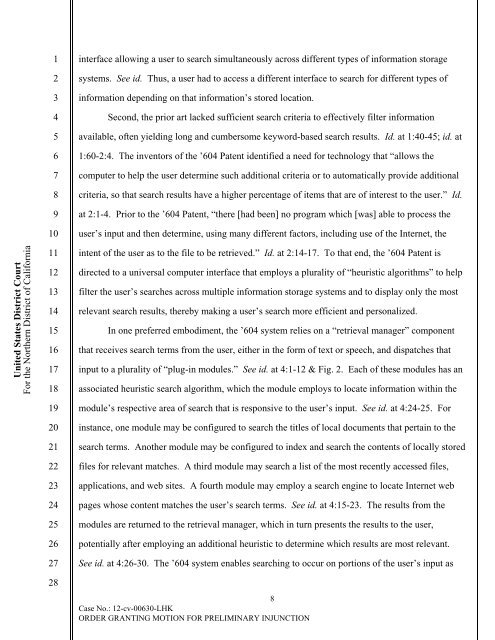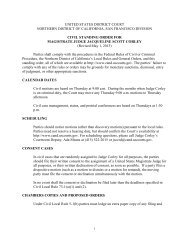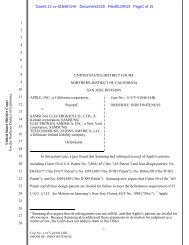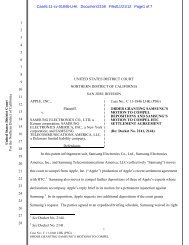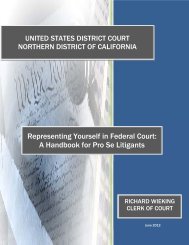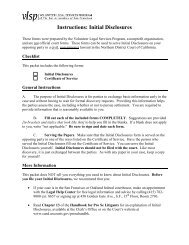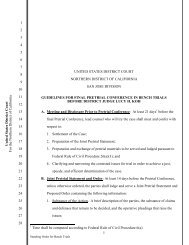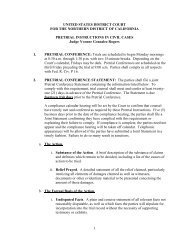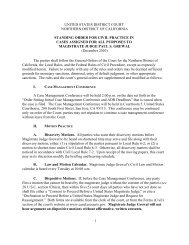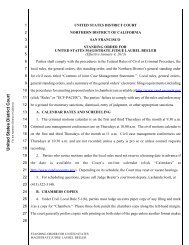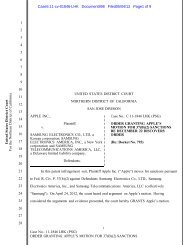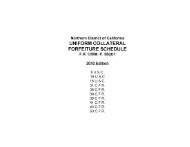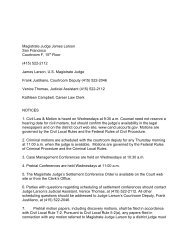Order Granting Motion For Preliminary Injunction - United States ...
Order Granting Motion For Preliminary Injunction - United States ...
Order Granting Motion For Preliminary Injunction - United States ...
You also want an ePaper? Increase the reach of your titles
YUMPU automatically turns print PDFs into web optimized ePapers that Google loves.
<strong>United</strong> <strong>States</strong> District Court<br />
<strong>For</strong> the Northern District of California<br />
1<br />
2<br />
3<br />
4<br />
5<br />
6<br />
7<br />
8<br />
9<br />
10<br />
11<br />
12<br />
13<br />
14<br />
15<br />
16<br />
17<br />
18<br />
19<br />
20<br />
21<br />
22<br />
23<br />
24<br />
25<br />
26<br />
27<br />
28<br />
interface allowing a user to search simultaneously across different types of information storage<br />
systems. See id. Thus, a user had to access a different interface to search for different types of<br />
information depending on that information’s stored location.<br />
Second, the prior art lacked sufficient search criteria to effectively filter information<br />
available, often yielding long and cumbersome keyword-based search results. Id. at 1:40-45; id. at<br />
1:60-2:4. The inventors of the ’604 Patent identified a need for technology that “allows the<br />
computer to help the user determine such additional criteria or to automatically provide additional<br />
criteria, so that search results have a higher percentage of items that are of interest to the user.” Id.<br />
at 2:1-4. Prior to the ’604 Patent, “there [had been] no program which [was] able to process the<br />
user’s input and then determine, using many different factors, including use of the Internet, the<br />
intent of the user as to the file to be retrieved.” Id. at 2:14-17. To that end, the ’604 Patent is<br />
directed to a universal computer interface that employs a plurality of “heuristic algorithms” to help<br />
filter the user’s searches across multiple information storage systems and to display only the most<br />
relevant search results, thereby making a user’s search more efficient and personalized.<br />
In one preferred embodiment, the ’604 system relies on a “retrieval manager” component<br />
that receives search terms from the user, either in the form of text or speech, and dispatches that<br />
input to a plurality of “plug-in modules.” See id. at 4:1-12 & Fig. 2. Each of these modules has an<br />
associated heuristic search algorithm, which the module employs to locate information within the<br />
module’s respective area of search that is responsive to the user’s input. See id. at 4:24-25. <strong>For</strong><br />
instance, one module may be configured to search the titles of local documents that pertain to the<br />
search terms. Another module may be configured to index and search the contents of locally stored<br />
files for relevant matches. A third module may search a list of the most recently accessed files,<br />
applications, and web sites. A fourth module may employ a search engine to locate Internet web<br />
pages whose content matches the user’s search terms. See id. at 4:15-23. The results from the<br />
modules are returned to the retrieval manager, which in turn presents the results to the user,<br />
potentially after employing an additional heuristic to determine which results are most relevant.<br />
See id. at 4:26-30. The ’604 system enables searching to occur on portions of the user’s input as<br />
8<br />
Case No.: 12-cv-00630-LHK<br />
ORDER GRANTING MOTION FOR PRELIMINARY INJUNCTION


